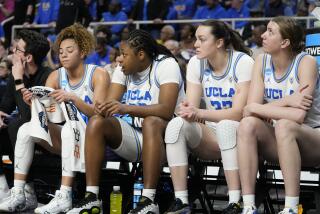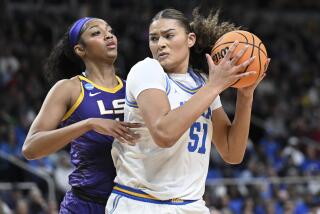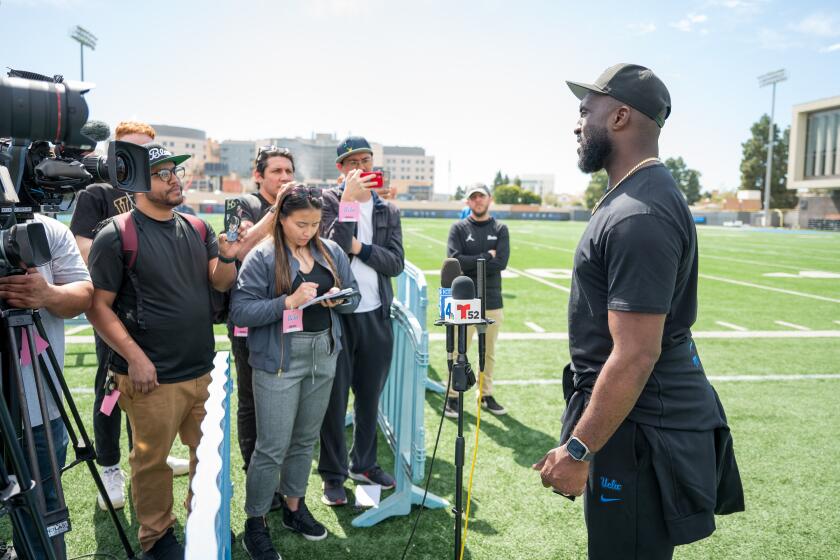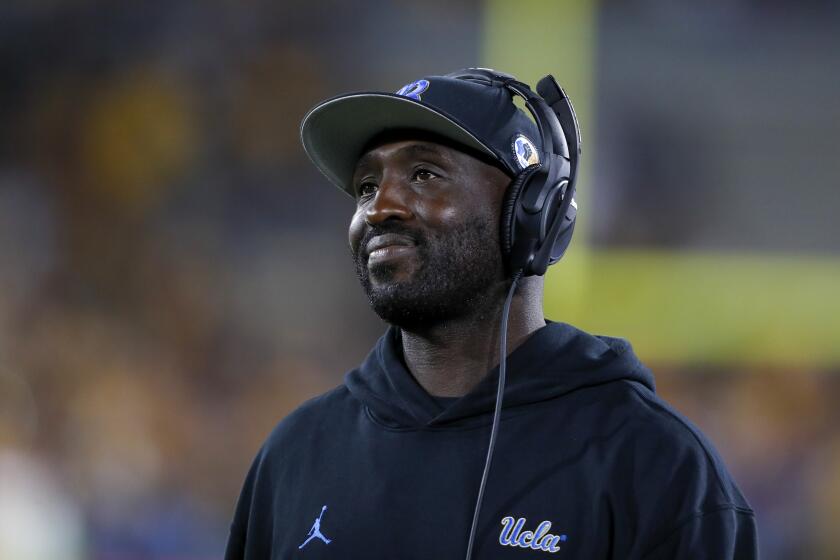Learning to share is big part of UCLA’s run to NCAA tournament Sweet 16

UCLA’s lead over Alabama Birmingham in an NCAA tournament round-of-32 game still wasn’t safe when Bryce Alford passed up a layup, lobbed an alley-oop pass to Norman Powell and watched as the ball went out of bounds.
Coach Steve Alford’s voice was loud enough to hear across the arena.
“Shoot the ball!” he barked at his son. “Shoot the ball!”
The team, and Bryce Alford in particular, were criticized for selfish play at times this season, by paid and unpaid analysts alike, but statistics indicate UCLA’s offense is among the most balanced left in the NCAA tournament.
Even though it was a mistake, the errant alley-oop pass was indicative.
The Bruins aren’t the best team remaining — at No. 11, they’re the lowest seed still playing — but they are the only team that has all five starters with scoring averages in double figures.
That kind of balance has made UCLA difficult to defend. In each of the four games the Bruins have played in the Pac-12 Conference and NCAA tournaments, different players have led the team in scoring.
“Five guys in double figures in our starting lineup, that’s kind of who we’ve been all year,” Steve Alford said. “So to do that in the national tournament, that’s the balance that, when we’ve been good, we’ve gotten during the year.”
For most of the season, Bryce Alford led the team in shots taken, though Powell has since overtaken him. That’s not ideal for a point guard. But an examination of UCLA’s shot distribution shows the ball is shared fairly evenly.
There is an analytic that shows the percentage of a team’s shots each player takes according to the minutes he plays. Powell, the team leader, takes 25.8% of UCLA’s shots when he is in the game, according to kenpom.com. Isaac Hamilton, at 19.1%, is the lowest among Bruins starters. Alford, at 23%, is only slightly above average.
Gonzaga, UCLA’s opponent Friday in a South Regional semifinal at Houston, also has a balanced attack — the scoring averages of the starters are all between 17.1 and 8.4 — but the Bulldogs rely more heavily on one player. Forward Kyle Wiltjer, a transfer from Kentucky, takes 31.8% of Gonzaga’s shots, which is the highest percentage of any player remaining in the NCAA field.
That said, Wiltjer, the Bulldogs’ leading scorer, is a deadeye marksman. He shoots 54.8% overall and 47.9% from three-point range. Four of Gonzaga’s top five scorers shoot better than 52%, and the Bulldogs are at 52.6% as a team.
Tony Parker’s 54.9% shooting — mostly from close range — leads UCLA, which shoots 44.5% as a team.
“They’re not as explosive as Gonzaga,” television analyst Kenny Smith said of the Bruins.
However, they might be less predictable, and that’s one reason UCLA is still playing.
These are the scoring leaders from the Bruins’ last four games:
Hamilton had a career high 36 points in a Pac-12 quarterfinal rout of USC.
Powell had 21 points in a tight Pac-12 semifinal loss to Arizona, even though he was working against excellent defenders in Rondae Hollis-Jefferson and Stanley Johnson.
Bryce Alford had 27 points, on nine three-point baskets, in an upset win over Southern Methodist in UCLA’s NCAA tournament opener.
Parker had a career-high 28 points against Alabama Birmingham.
That leaves Kevon Looney as the only starter who has yet to lead the team in scoring since the end of the regular season. Looney, widely regarded as UCLA’s most promising NBA prospect, averages 11.6 points but has scored five, five, six and 10 in the last four games.
When all five UCLA starters are clicking, “they complement each other well,” said Jim Spanarkel, a broadcaster who called both of UCLA’s NCAA tournament games.
The Bruins like to work the ball inside to Parker and Looney, hoping if they convert it will create space on the perimeter.
“If we can get the big fellow going and get him easy buckets at the beginning of the game, it opens everything up,” Bryce Alford said.
Parker joked that Bryce Alford’s passing, while effective, is really just a way to get back at his father, an All-America guard at Indiana in the 1980s.
“Coach Alford didn’t pass much,” Parker deadpanned after the Alabama Birmingham game. “So I think Bryce focuses on being a better passer than him.”
More to Read
Go beyond the scoreboard
Get the latest on L.A.'s teams in the daily Sports Report newsletter.
You may occasionally receive promotional content from the Los Angeles Times.







